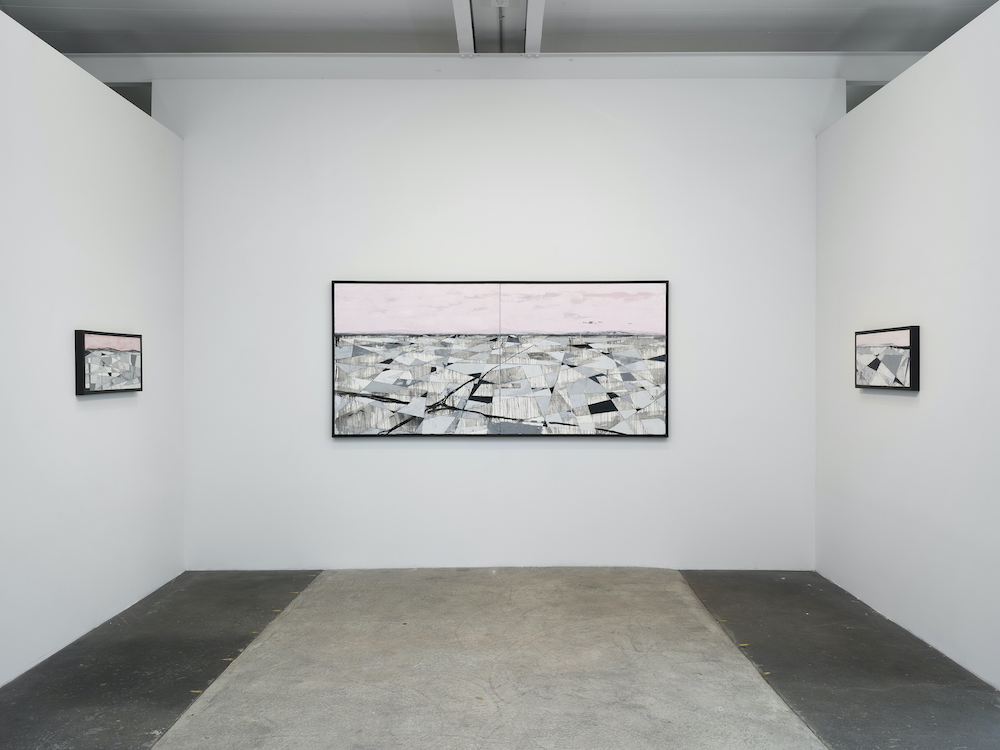A native of the San Fernando Valley, painter Karla Klarin has long been interested in the Los Angeles cityscape. She depicts the city’s sprawl as an abstraction, and she fills her scenes with different colors that extend across her compositions. In her early paintings like Valley View (1983) and Monster Twins (1983), Klarin captured expansive freeways and modern high-rises. Her recent, large-scale cityscapes LA Boogie Woogie (2022) and For Piet (2019) are, as their titles suggest, Mondrian-esque works with crisscrossing diagonals that reference the planes of landscapes leading towards a horizon filled with mountains and the sky beyond.
The works that comprise “Big Pink” explore Klarin’s memories of a pink-hued house that belonged to her neighbor Natalie. In the series’ earliest paintings, Klarin combines architectural precision with broad, washy brushstrokes to depict a typical Los Angeles tract home; a one-story house with an attached garage and low-pitched roof. Klarin’s illustrations appear as arrays of rectangular, textured shapes filled with swirling lines. The house’s particular pink color works as a point of departure for Klarin’s subsequent paintings.
In her later paintings, Klarin delights in abstraction—allowing the planes of architecture to morph into a more expansive landscape of interlocking triangles and trapezoids in shades of gray against a light pink sky. While she creates both small and large paintings, it is the larger works (more than 90 inches across) like Big Pink LA 1 (2017), Big Pink LA 2 (2016), and Big Pink LA 4 (2021) that evoke the sprawl that characterizes the terrain of Los Angeles.
The thick black brush strokes that crisscross Big Pink LA 1 are reminiscent of the freeways that cut the city into oddly shaped pieces. Klarin’s works have a map-like presence with the paintings unfolding as irregular grids beneath an impasto sky. Klarin cites Richard Diebenkorn and his Ocean Park paintings from the 1960s as an influence and there are parallels in how both artists abstract the landscape into geometric shapes and striations. While there is no “real” pathway to navigate Big Pink LA 4, an area of dripping black brush strokes toward the bottom left of the painting suggests the on/off ramps of a freeway as it extends across the composition and fades into a pink haze. The painted sections are assembled like pieces of a complex puzzle combined to create what Klarin terms “spacial vistas” and “gridded neighborhoods.”
Klarin’s smaller paintings are more intimate and can be thought of as excerpts from the larger works. These numbered “Landscape Studies” range in size from approximately 13 x 27 inches to 25 x 53 inches and have the same colors and fragmented perspectival space as the larger works. For example, Landscape Study 88 (2018) is simultaneously a geometric abstraction filled with gray and white trapezoids of differing opacities, and a representation of a slice of urban sprawl that’s focal point is the horizon line—where flat land becomes mountain and meets the sky. The large triangular shape that dominates both Landscape Study 125 and Landscape Study 140 (both 2020) recalls sci-fi excavations drawn in perspective. In Klarin’s imagination, these are undeveloped and uninhabitable places, rendered in black and white and set against a faded pink horizon, foretelling the future of Los Angeles.
Klarin has been a longtime resident and astute observer of how Los Angeles changes. While she portrays LA as a decentralized concrete jungle and a barren, people-less place filled with an uncanny pink sky above an ever-changing grid, it is done with admiration and respect rather than disdain. Klarin loves to paint what surrounds her and to represent the sprawl as an evocative geometric abstraction.
Vielmetter Los Angeles
1700 S Santa Fe Avenue #101
Los Angeles, CA 90021
On view through July 8, 2023


